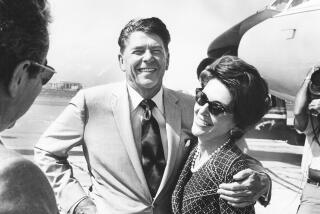Junipero Serra, California’s founding father
Many powerful Californians have left their mark on the state. But I’d argue that the most lasting legacy, for better and for worse, belongs to a controversial man of the cloth born 300 years ago this year: Father Junipero Serra.
The trail of missions he began building in 1769 would eventually stretch from San Diego to Sonoma, creating a foundation for Catholicism in California that remains solid today. But Serra’s influence extended well beyond the realm of religion.
More than Spanish names on a map, the missions, presidios and pueblos of Serra’s day, as well as the roads between them and the resources their inhabitants organized and developed, formed the spine of what would become the nation’s 31st state.
With Serra came soldiers and settlers who flourished, forming large families and creating the beginnings of a vibrant local agricultural and commercial economy. Mission architecture became the style of the state, something real estate developers embraced as a means of linking an unfamiliar place to a romanticized past, as millions of people moved west to take advantage of California’s affordable housing, mild climate and booming economy.
Serra lived at about the same time as Benjamin Franklin, George Washington and Thomas Jefferson, but he was a founding father of a completely different sort. Rather than launch an experiment of self-governance rooted in Enlightenment thinking, Serra brought to this land older patterns of European life and belief. And in California, to which he came at age 55, he instigated a revolution of ideas and practices that altered not only the people but also the land.
With Serra came horses, mules, oxen and sheep, and they multiplied and thrived. They also devastated indigenous plants and animals, shaping much of California’s now iconic landscape of hillsides barren of all but oaks and dry grass. The state’s indigenous people were forced to find new food sources, and many of them had little choice but to leave their villages for missions.
Once the Indians arrived, the missionaries worked to radically change the way they produced and consumed food. These first Californians had managed the environment so well that hundreds of thousands comfortably lived here in 1769. But Serra shifted the emphasis from planned burning and skillful gathering to irrigation and the cultivation of crops, believing fervently that only by working in fields plowed and watered in a European fashion would Indians begin to adopt Spanish ways and Catholic beliefs.
Serra’s insistence that Indians farm as Europeans and live year round in the missions meant they had a narrower diet, and the concentration of large numbers of people into missions meant increased exposure to disease and soaring death rates.
As hundreds of native villages across much of California disappeared, Spaniards and others claimed Indian lands and created the sprawling cattle ranchos that became so vital to the economy of California in the mid-19th century. California’s Indians, meanwhile, were pushed to the margins of society for generations.
No doubt some Indians welcomed the food, shelter and new beliefs of the missions. But the colonial storm that overwhelmed them was so intense that to this day the remnants of most Indian groups between San Diego and San Francisco go unrecognized as tribes by federal authorities. That means they are denied access to federal programs that support other Indian groups.
Today, against towering odds and extreme social pressures, many continue the hard work of rebuilding their communities, recovering their languages and reconnecting to ancient and powerful ways of being, often, ironically, through the creative use of the very parish records that Serra inscribed as a means of documenting their baptism.
If you grew up in California, you have probably found yourself on El Camino Real — the King’s Highway — with its historical markers shaped like mission bells, or driven on the Junipero Serra Freeway (the I-280). You may have made a model of the missions in fourth grade, or lived in a house with a red-tiled roof. But in this year, the tercentennial of Serra’s birth, for all of these reasons, you might want to pay more attention to those familiar Serra monuments and roadside bells that form the backdrop of our lives.
More than just reminders of the power of faith to motivate human action, and of the willingness of men like Serra to devote their lives to what they saw as a greater cause, these symbols speak of the painful and transformative interactions Spaniards initiated with Native Americans.
California’s missions were not simply places where Franciscans acted out their ambitious dreams but sites where Indians, in the face of disease and overwhelming pressure to assimilate to European ways, persisted in their beliefs under the most difficult of circumstances. The missions are also a reminder of California’s place in a world history shaped by conquest and underscored by tragedy. Serra helped lay a foundation for California, as flawed as that foundation may be, and his ever presence can remind us of the achievements and costs inherent in his doing so.
Steven W. Hackel is a professor of history at UC Riverside and the author of “Junipero Serra: California’s Founding Father.” He co-curated an exhibition about Serra on view at the Huntington Library.
More to Read
A cure for the common opinion
Get thought-provoking perspectives with our weekly newsletter.
You may occasionally receive promotional content from the Los Angeles Times.










